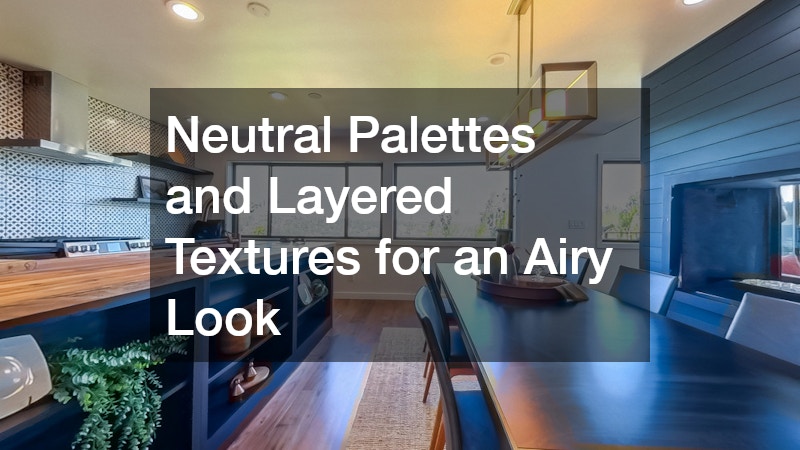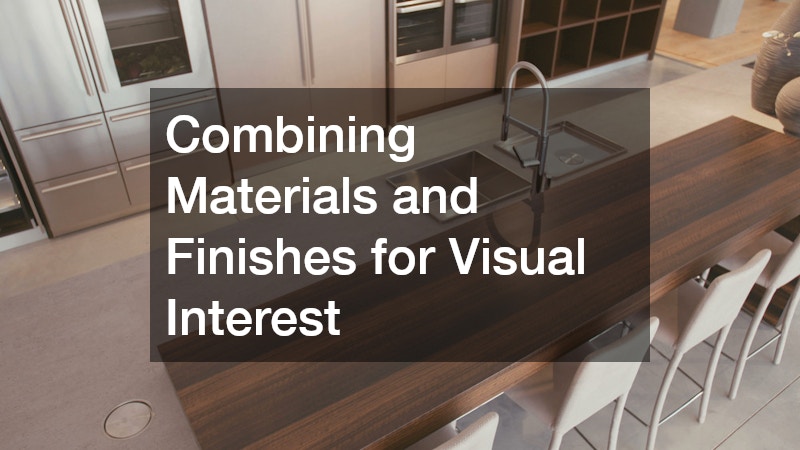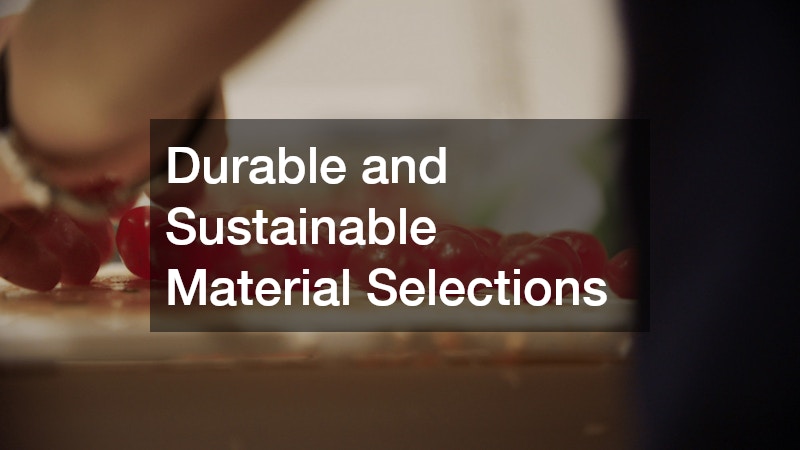The modern kitchen continues to evolve as both a functional workspace and a primary gathering point in the home. Homeowners today look for spaces that balance efficiency, comfort, and a polished style that reflects their personal tastes. Trends within contemporary kitchens highlight simplicity, streamlined layouts, and an intentional focus on materials and features that support easy day-to-day use. Smooth surfaces, uncluttered storage systems, and a lighter, more natural color palette are among the most noticeable elements in today’s updated kitchens. These changes aim to create an environment that feels open and restful while still supporting all the necessary tasks that occur in this central room. Understanding current approaches to a clean and modern look can support thoughtful planning, informed decision-making, and a cohesive result that maintains visual appeal over time.
Embracing Minimalist Layouts for Functionality and Flow
Minimalist layouts focus on reducing visual noise and allowing the eye to move comfortably through the space. This approach is one of the most defining characteristics of contemporary kitchens. It involves more than choosing fewer decorative items; it centers on creating intentional space, allowing cabinets, appliances, and countertops to have breathing room. Clean lines, simple silhouettes, and streamlined arrangements are now central to many households that want a calm yet efficient setting.
One of the goals during a kitchen remodel is to develop a space that feels purposeful. Rather than filling corners with additional storage or small appliances, modern layouts prioritize clear surfaces and integrated functionality. Hidden storage solutions help reduce clutter, while open layouts support natural movement between preparation zones, cooking areas, and gathering spaces. This arrangement often involves reevaluating how the layout supports everyday living. For example, the classic triangle between stove, sink, and refrigerator still appears in many updated kitchens, but with more flexibility to accommodate island seating, pantry centers, or wall ovens.
As homeowners outline their goals, many also collaborate with professionals who assist with thoughtful planning and execution of kitchen design. Those providing home remodeling services can offer insight into structural allowances, the feasibility of layout adjustment, and methods to refine the spatial balance. When people decide they want the kitchen to be easier to navigate, free of unnecessary crowding, and visually calming, a minimalist floor plan can meet these needs without sacrificing usability. Achieving a successful minimalist environment requires attention to scale as well. For instance, if a large island dominates the room, it may interrupt the intended flow; selecting appropriately sized surfaces supports openness.
Design details also contribute to the visual clarity of a minimalist layout. Handles and hardware may be reduced or replaced with integrated pulls, upper cabinets may give way to floating shelves, and lighting fixtures often lean toward understated forms that enhance brightness without demanding attention. The result is a layout that feels both modern and timeless. This approach works well regardless of whether the kitchen is large or compact because the core concept rests on making the most of what is available rather than adding more. Overall, embracing a minimalist arrangement supports both a cleaner visual atmosphere and a more relaxed cooking experience.

Neutral Palettes and Layered Textures for an Airy Look
Color plays a significant role in shaping the overall feel of a kitchen. Modern trends favor soft and neutral palettes to convey brightness, calmness, and versatility. White, beige, warm gray, matte taupe, and light natural wood tones dominate contemporary kitchens, helping the space feel open and inviting. These hues also reflect available light, which contributes to the perception of a larger and more comfortable room. However, neutral does not mean flat or dull. The beauty of a modern kitchen lies in the layering of different natural textures and subtle color variations to bring richness without overwhelming the senses.
A kitchen remodel that incorporates neutral colors often pairs them with natural materials such as quartz countertops, light oak cabinets, and stone or ceramic elements that add depth. Layering texture allows the space to remain visually interesting without relying on bold accents or pattern-heavy surfaces. For example, a backsplash with a handcrafted finish can complement smooth, contemporary cabinetry. Similarly, a softly veined countertop or a subtly grained wood floor adds organic character that remains aligned with the broader minimalist aesthetic.
Selecting the right surfaces and finishes also involves consistency. Too many competing textures can make the room feel unfocused, while too few can create monotony. Many homeowners choose one visual anchor—such as the backsplash or a section of exposed shelving—and then select surrounding elements that support that focal point. This approach helps produce a balanced look that appears curated rather than accidental.
Color shifts also naturally touch on the importance of surface finishes. Matte finishes often play a strong role in contemporary kitchens because they reduce glare and lend a more understated appearance. For example, matte cabinet fronts pair well with brushed or satin hardware, creating a cohesive flow. The smoother finish supports a clean atmosphere and is less visually abrupt than glossy curved details.
When refinishing existing cabinetry or adding subtle accents, homeowners may consult painting contractors who understand how to suggest finishes that maintain the streamlined look of the modern kitchen. Smooth applications, carefully chosen undertones, and appropriate sheen levels are critical to preventing streaking, uneven coloration, or unintended contrast. Much of the modern appeal lies in how well each element complements the others, making careful color and finish decisions essential.
Innovative Storage and Organization Solutions
Storage remains one of the most influential components of a modern kitchen. The shift toward simplicity and visual calm drives a need for storage that conceals everyday items while keeping them easily accessible. Overhead cabinets, base drawers, wall-mounted shelving, and hidden compartments contribute to an environment free of clutter. The focus is on both clean appearance and functional depth.
In a kitchen remodel centered on organization, drawers may replace traditional lower cabinets because they offer easier access to stored pots, pans, and dishware. Full-extension slides allow individuals to reach the back of a drawer without bending or rearranging items. Vertical dividers can organize baking sheets and cutting boards in a dedicated space, preventing crowding and tipping. Pull-out pantry units, whether tall or base-sized, optimize narrow spaces that may otherwise remain unused. These thoughtful storage features support efficiency and reduce the sense of visual overload.
Cabinet companies play a key role in shaping how storage contributes to the final result. Their products allow homeowners to choose solutions that match both the practical needs and the preferred aesthetic of their kitchen. Some households may elect to use taller upper cabinets to maximize vertical storage space, while others might incorporate open shelving for a more airy atmosphere. Whatever the preference, the overall goal remains a simplified and cohesive system that helps maintain cleanliness.
Drawer inserts, spice pull-outs, and utensil organizers enhance daily functionality by giving each item a defined place. When these features are planned early, they help prevent clutter from accumulating over time. The way storage integrates into the space matters just as much as the cabinet capacity itself. Homeowners often select a combination of concealed and display storage, such as a large pantry closet paired with floating shelves showcasing glassware or a curated set of decorative items. This balance ensures that personal style remains visible while everyday essentials remain tucked away.

Combining Materials and Finishes for Visual Interest
Modern kitchens often blend multiple materials to create a layered yet cohesive appearance. This trend allows homeowners to express personal preference while still maintaining an overall unified look. A mixture of matte and polished finishes, warm and cool tones, and natural and contemporary textures can help prevent the space from feeling flat. The blending of materials supports visual richness without compromising simplicity.
In many homes, a kitchen remodel that incorporates different materials might use wood cabinets, quartz or stone surfaces, glass pendant lighting, and stainless steel appliances. This multi-layered combination introduces subtle contrasts that contribute to depth and interest. For example, a wooden island paired with smooth stone counters provides a grounded yet refined centerpiece. Maintaining balance is essential; selecting a few key materials and repeating them throughout the space helps avoid a mismatched appearance.
The precision of craftsmanship also influences how well these blended finishes work together. Partnering with a custom cabinet maker allows homeowners to tailor cabinetry design, textures, and colors to harmonize with surrounding surfaces. Rather than adapting to pre-set sizing or finishes, custom-built cabinetry aligns directly with layout preferences and design vision. Pairing personalized cabinetry with carefully chosen countertop services supports a unified and intentional final result.
Hardware selection also affects how materials interact. Knurled handles, brushed metal drawer pulls, and minimalistic knobs offer a modern edge without drawing too much attention. The right hardware offers tactile comfort while supporting the visual direction of the room. When hardware complements the surrounding textures, the effect contributes to an environment that feels both calm and curated.
Lighting Strategies to Enhance Clarity and Warmth
Lighting shapes the atmosphere of a kitchen in both practical and aesthetic ways. Bright, even illumination is essential for food preparation, while softer ambient lighting supports a warm and welcoming environment when guests gather. Modern kitchens typically integrate three primary lighting types: ambient, task, and accent lighting. These layers ensure that different areas of the room remain functional and visually appealing.
A kitchen remodel may introduce recessed lighting to provide overall brightness, under-cabinet lights to illuminate prep surfaces, and pendant lights to highlight an island or dining area. The combination of these sources helps reduce shadows and ensures that work areas receive adequate light. Additionally, the placement of lighting fixtures contributes to how spacious the room appears. Strategically positioned fixtures can draw the eye outward, making the room feel larger and more open.
Technology also influences lighting options. Many homeowners now select dimmable LEDs to control brightness levels depending on the time of day and purpose. Natural light remains equally important. Large windows, glass doors, or skylights can dramatically brighten the kitchen and provide a connection to the outdoors. Upgraded lighting systems can be both energy-efficient and long-lasting.
The planning process may involve local electrical services to ensure safe, compliant installation. Expert guidance helps confirm that circuits support appliance loads, switch placement aligns with traffic patterns, and lighting controls function smoothly. Incorporating lighting early in the design process prevents last-minute adjustments that could disrupt the clean, modern aesthetic.

Durable and Sustainable Material Selections
Sustainability has become an increasingly influential element in modern kitchen planning. Many homeowners seek materials that are both long-lasting and environmentally conscious. Sustainability may involve selecting products with low environmental impact, choosing finishes that require minimal harsh chemicals to maintain, or investing in surfaces that resist wear and damage.
A kitchen remodel that prioritizes sustainability may feature responsibly sourced wood, recycled or engineered stone countertops, and energy-efficient appliances. These choices not only contribute to reduced environmental impact but also offer long-term value. Durable surfaces reduce the need for frequent repairs or replacement, helping maintain a clean and orderly kitchen for years.
Flooring also contributes significantly to both durability and appearance. Materials such as tile flooring provide a stable, long-lasting foundation that withstands regular foot traffic, accidental spills, and cleaning routines. Selecting flooring with a finish that resists staining and moisture supports a consistently polished environment. Coordination between flooring, cabinetry, and countertops allows the kitchen to feel unified and proportional.

Technology and Maintenance Features for Everyday Ease
Technology plays a growing role in shaping how kitchens function. Modern appliances offer advanced features such as touch controls, efficient cooling systems, automatic shutoff settings, and integrated connectivity. Smart technology contributes to convenience and can streamline meal preparation and cleaning. Hidden outlets, charging drawers, and voice-activated lighting systems also help maintain a clean visual space while enhancing usability.
Daily maintenance remains an essential factor in keeping the kitchen looking refined. Small additions, such as effective grease removal systems in stove hoods or ventilation units, contribute to healthier indoor air and reduce buildup on surfaces. These features help keep the kitchen clean and extend the life of surrounding materials. Selecting appliances and fixtures that simplify cleaning can prevent surface dulling and long-term wear.
Plumbing improvements also influence efficiency and ease of maintenance. Whether updating faucets, dishwashers, or sink configurations, involving local plumbing services ensures that installation aligns with safety standards and performs reliably over time. Coordinating plumbing upgrades during larger kitchen changes can prevent future disruptions and reinforce the overall cohesiveness of the renovation.
In many cases, homeowners rely on professionals who support the entire renovation process from start to finish. These professionals help integrate both aesthetic and functional upgrades that elevate the space. As modern kitchens continue evolving, thoughtful consideration of materials, storage, lighting, and technological additions ensures the kitchen remains both attractive and easy to maintain.


